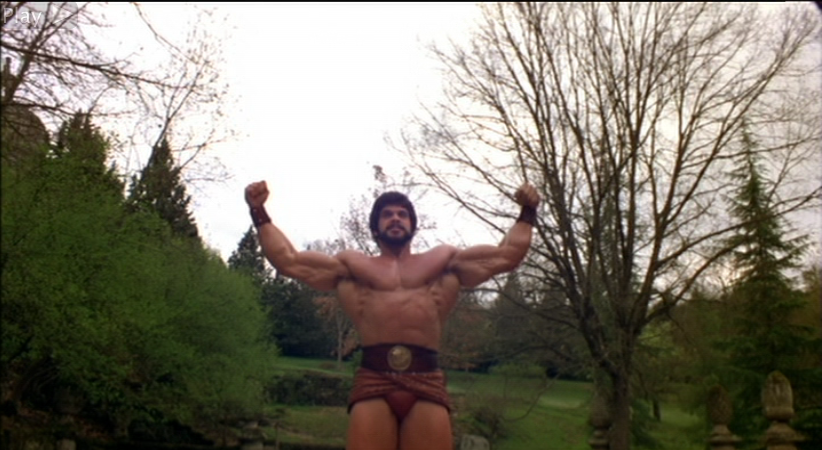Written By Zak Attack
A dramatic journey through the dreck we all know and love
Why Did I Watch This?
In anticipation of the new movie starring Dwayne “The Rock” Johnson, it’s Hercules Month at Why Did I Watch This!! If you missed Part One, check it out here: Hercules Vs. Hydra
In keeping with last week’s sword-and-sandal genre, for Part Two we are looking at another production with a predominately Italian cast and crew starring an American Hercules. It was also produced by Golan-Globus, for which I clearly have a soft spot. Either way, it has a bit of a cult following and was apparently on IMDb’s Bottom 100 for a short period.
How Did I Watch It?
My viewing of Hercules was pretty straightforward. But… since the dvd was double-sided, I flipped it over and also watched the 1985 sequel The Adventures of Hercules. That’s right, folks. We got two famously bad Hercules movies for the price of one. That’s what Hercules Month is all about!
What Did I Watch?
The real selling point for these movies is that they attempt to interpret a version of Hercules for the 80’s. The women are busty, the outfits are ostentatious, and the cheese is palpable.  But where the movies really stand out are with the more “modern”, cosmic background for Mount Olympus and the gods. It’s like the filmmakers saw the milquetoast health spa in the clouds from (the original) Clash of the Titans and said “Fuck that! It’s the 80’s! Let’s set the movie in a discotheque in space! Now pass me that cocaine.”
But where the movies really stand out are with the more “modern”, cosmic background for Mount Olympus and the gods. It’s like the filmmakers saw the milquetoast health spa in the clouds from (the original) Clash of the Titans and said “Fuck that! It’s the 80’s! Let’s set the movie in a discotheque in space! Now pass me that cocaine.”
1983’s Hercules establishes its ridiculous tone pretty early. The Cannon production clearly has no interest in exploring the ancient mythology and just does whatever the hell it wants. For instance, in the opening narration we’re introduced to Pandora’s Lite-Brite jar of existence, which straight up explodes and creates the universe by unleashing the “four basic elements”: Night, Day, Matter, and Air (I guess Earth, Wind, and Fire were busy with their recording career by this point). The gods, who live on the moon and only consist of Athena, Hera, and Zeus; decide that humans need a champion, so they create Hercules (Lou Ferrigno).
For his whole life, Hercules is constantly attacked by the evil King Minos (William Berger) and his patron, Dedalos, a celestial agent of chaos (famous intersex actress Eva Robin’s). His run-ins with ‘chaos’ eventually leave him an orphan, so Hercules goes to find his fortune and take advantage of his considerable strength by competing in a sparsely attended tournament. During this time, he falls in love with the Princess Cassiopea (Ingrid Anderson) who is kidnapped by Minos and his scantily clad minion on Earth, Ariadne (Sybil Danning).
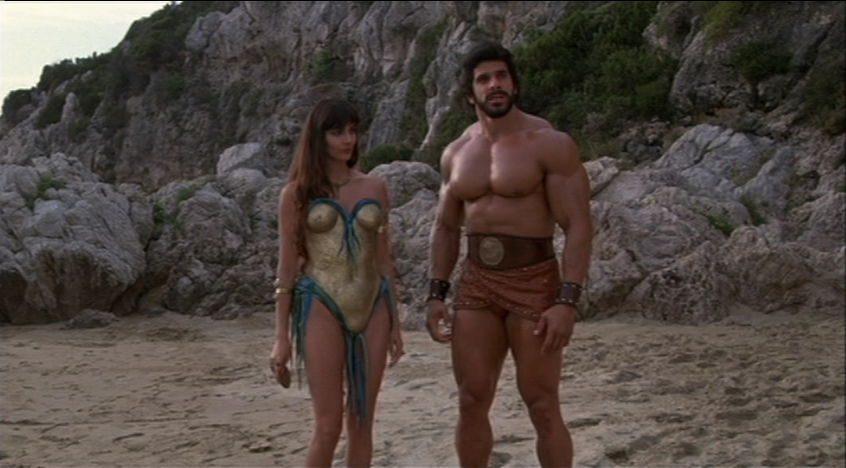 And so begins the initiation portion of our hero’s quest. Hercules befriends the attractive sorceress Circe (Mirella D’Angelo) and they make their way to rescue Cassiopea by traveling to the great city of Thera. There he confronts and defeats King Minos and is immortalized forever as a constellation along with his rescued princess.
And so begins the initiation portion of our hero’s quest. Hercules befriends the attractive sorceress Circe (Mirella D’Angelo) and they make their way to rescue Cassiopea by traveling to the great city of Thera. There he confronts and defeats King Minos and is immortalized forever as a constellation along with his rescued princess.
It’s an imaginative, if strange, world that Ferrigno’s Herc inhabits which at least makes for an entertaining movie. Miniatures and stop-motion are used to pretty cool effect in creating this unmistakably 1980’s take on ancient Greek religion. During this action-packed journey, Hercules fights a whole bunch of weird stuff: a bear, a giant robot bee, two dudes in chariots, eight regular dudes, a giant robot centaur, a giant robot dragon, King Minos, and the half-naked Ariadne. The majority of these threats are part of Minos’ evil plan, which, unfortunately has little room for logic or critical thinking. Minos’ entire goal is to disgrace the Gods and use science to take over the world. Despite the troubling ramifications of a film that says outright that science is evil, the science doesn’t even sound much like “science”. When Dedalos produces the three tiny robot animals to attack Hercules with, the science-loving king questions their efficacy. 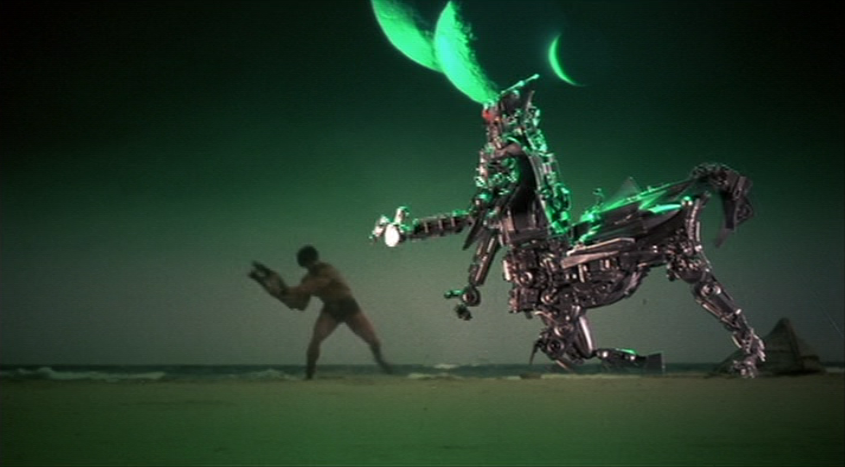 She notes that size is relative, in addition to time and space. Minos replies with understanding “Ah, so of course the atmosphere of Earth will make them grow to a terrific size.” Right. Science.
She notes that size is relative, in addition to time and space. Minos replies with understanding “Ah, so of course the atmosphere of Earth will make them grow to a terrific size.” Right. Science.
But that’s nothing compared to the terrible and absurd sequel The Adventures of Hercules. The film begins when Zeus (Claudio Cassinelli) revives Hercules from his immortal place in the heavens in order to procure his seven lost thunderbolts (more accurately “lightning bolts”, but whatever), which were stolen by Hera (Maria Rosaria Omaggio) and given to protectors across the countryside. Of course, the first act involves Hercules just roaming around, stumbling backassward into thunderbolts. Eventually, he meets up with prophetic sisters Urania and Glaucia (Milly Carlucci and Sonia Vivani). The two sisters request his help as they are in danger of being sacrificed to fire monster Antaeus, who also happens to be in possession of a thunderbolt.
In the meantime, some of the gods have decided to rebel against Zeus and revive King Minos in order to stop Hercules in his quest. Minos, however, has ulterior motives and double-crosses the gods. We eventually arrive at a final showdown where Hercules is, again, triumphant. Unfortunately, the fight scene is an unimpressive laser light show in space rotoscoped from the same climactic fight from the first film. Hercules and Minos also morph into a laser gorilla and dinosaur/snake (respectively) for the finale. I shit you not.
And it’s not just his own movie that director Luigi Cozzi lifts from. There is also an interpretation of the slaying of Medusa that, mind you, was coming to audiences only four years after the original Clash of the Titans. The evil gorgon is portrayed as stop-motion scorpion/woman and, well, Ray Harryhausen this ain’t.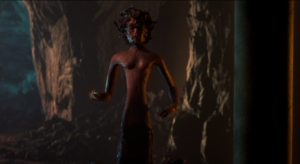 When Cozzi isn’t utilizing simplistic traditional animation in a composite shot with live-action (the monster Antaeus is made entirely out of light), he’s implementing some pretty bad stop-motion techniques. The special effects are dire even in relation to the rest of Hercules’ questionable cinematic history.
When Cozzi isn’t utilizing simplistic traditional animation in a composite shot with live-action (the monster Antaeus is made entirely out of light), he’s implementing some pretty bad stop-motion techniques. The special effects are dire even in relation to the rest of Hercules’ questionable cinematic history.
Much like it’s predecessor, The Adventures of Hercules finds King Minos attempting to use science to destroy the gods. Also like that film, the explicit theme is that science is evil and religion is great. That might seem strange in a modern world of climate change and evolution deniers, but it becomes hilarious when you realize the screenwriter (Luigi Cozzi for both films) still doesn’t seem to know what science even is. I already mentioned the idea from Hercules that “size, like time and space, is relative”, but I’d also be remiss if I didn’t cite the following nonsensical line from Minos in the sequel: “For me, the goal of science is to release chaos and disorder.”
As with Mickey Hargitay in Hercules Vs. Hydra, Lou Ferrigno is dubbed in both films, but his over-the-top physical performance is something to be reckoned with. Ferrigno runs around, squishes up his face in pain, and goofily smirks to enjoyably embarrassing effect. The rest of the cast over-emotes as if some Shakespeare in the Park actors got roped into a very confused LARP event.
Highlight?
Hercules:
Without a doubt, the incredibly stupid bear fight. See for yourself:
There is quite a lot going on here to unpack, so let’s start at the beginning. The most obvious issue is the terrible bear costume that Lou Ferrigno wrestles with. To his Ed Wood-like credit, Cozzi also decides to throw in stock footage of a roaring bear of clearly different film quality. So, while the bear suit clearly isn’t fooling anybody, neither is the footage. In fact, the combination of the two awful ideas just adds to the hilarity. However, the most bizarre part is where he up and launches the bear into space (creating a version of Ursa Major that looks nothing like the actual constellation).  While that is humorous in its own dumb way, I think my favorite part is how the moment plays as Hercules’ reaction to his father’s death throes. He doesn’t come running to his father’s side to see if that truly was his last breath. Nay! The strongman protagonist bugs out and chucks the bear’s corpse into the heavens like a furry dummy of death.
While that is humorous in its own dumb way, I think my favorite part is how the moment plays as Hercules’ reaction to his father’s death throes. He doesn’t come running to his father’s side to see if that truly was his last breath. Nay! The strongman protagonist bugs out and chucks the bear’s corpse into the heavens like a furry dummy of death.
Because the movie is set in space, Cozzi continues to get a lot of mileage from having his title character sending things into orbit. He defeats some tournament competitors with a giant log and throws the thing up in the air like a spear, creating Jupiter’s Great Red Spot. Circe and him have to take a chariot pulled by winged horses (pegasuses? pegasi?) in order to get to Thera. Since there are no flying beasts to be found, he asks Circe to tie a rock to the chariot (with telekinesis, because who needs hands?) and just flings the rock to the stars in order to get the chariot airborne.
The Adventure of Hercules:
While the sequel was pretty dire, the overall wackiness was kind of fun in its own special way. The laser light show climax, while intensely obnoxious (seeing as I had just watched the first one) ended up being so stupid that the whole concept completed a 180-degree turn and became funny.
I have a hunch that in addition to recycling the same fight scene from the first film, they also repurposed footage from the giant snake/ape battle in 1976’s King Kong, but my internet research was unable to confirm (EDIT: I was notified it was actually lifted from the original 1933 King Kong!).  Regardless, why did Minos turn into a tyrannosaurus rex and then into an anaconda? Why did Hercules turn into a gorilla? Being from Greece, how did either of them imagine such forms? Hell, why did they become cosmic laser beings in the first place? It doesn’t matter. Just point and laugh at the lousy images on the screen and everything should be fine.
Regardless, why did Minos turn into a tyrannosaurus rex and then into an anaconda? Why did Hercules turn into a gorilla? Being from Greece, how did either of them imagine such forms? Hell, why did they become cosmic laser beings in the first place? It doesn’t matter. Just point and laugh at the lousy images on the screen and everything should be fine.
Lowpoint?
The Adventures of Hercules:
I’m going to talk about the second film first here, because unfortunately The Adventures of Hercules is such a disaster. The seven thunderbolts quest is more than enough for a movie on its own, but the filmmakers feel the need to cram more and more into the 88 minute running time. This provides no room for anything to breathe. Here’s a sample of dialogue for your consideration:
Hercules: I must find a way to overcome the fire monster’s radiant heat. I am not immune to the energy Antaeus releases.
Urania: The Little People use cunning against power. I think they will listen to me.
Hercules: Then let us go to The Little People.
Urania: But to reach them we will have to cross The Doomed Forest where the demon Tartarus reigns.
Hercules: We can’t go back now.
Glaucia: Then you’ll save the maidens of Phaegesta?
Hercules: Fate has already willed it. Zeus has sent me here to find his mighty thunderbolts. And one of them is inside Antaeus’ belly.
Honestly, the whole movie is like that. The dialogue is so aggressively expository that one’s brain barely has any time to register the cause and effect of the many subplots in the movie. In addition, what that exchange doesn’t include is that The Little People then give our trio of heroes golden leaves from The Gardens of Hespa so they can breathe underwater to talk to some mermaids.  The mermaids then give Hercules a sacred balm made from three drops of the River Styx which will make the wearer resistant to the heat of Antaeus. Keep in mind, everything I have just explained covers the acquisition of only two out of the seven thunderbolts (Tartarus in The Doomed Forest and Antaeus) and describes the action of less than 14 minutes of film. Once you consider that over half the actors are dubbed and that nearly all the conflicts involve Hercules punching something… well, you can see what I’m getting at. This would even be a problem without Hera as the impetus for the plot or King Minos as the big baddie, who somehow acquires the ability to shoot lasers out of his eyeballs after being resurrected from the dead.
The mermaids then give Hercules a sacred balm made from three drops of the River Styx which will make the wearer resistant to the heat of Antaeus. Keep in mind, everything I have just explained covers the acquisition of only two out of the seven thunderbolts (Tartarus in The Doomed Forest and Antaeus) and describes the action of less than 14 minutes of film. Once you consider that over half the actors are dubbed and that nearly all the conflicts involve Hercules punching something… well, you can see what I’m getting at. This would even be a problem without Hera as the impetus for the plot or King Minos as the big baddie, who somehow acquires the ability to shoot lasers out of his eyeballs after being resurrected from the dead.
Hercules:
It’s incredibly hard to pick a lowpoint for this movie after watching The Adventures of Hercules. The original literally does everything better. Not only does it have objectively more effective storytelling, special effects, and acting but it is also the more entertainingly bad movie. 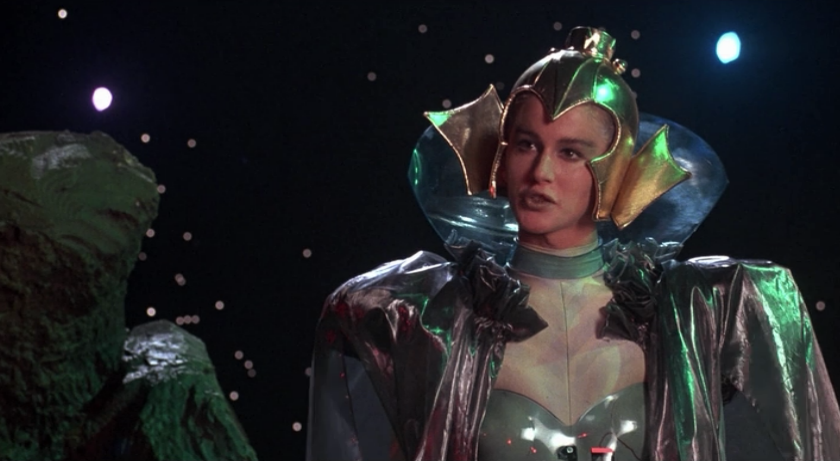 Everything that doesn’t work in Hercules doesn’t work in a way that makes you laugh. Everything that doesn’t work in the sequel slowly eats away at the soul.
Everything that doesn’t work in Hercules doesn’t work in a way that makes you laugh. Everything that doesn’t work in the sequel slowly eats away at the soul.
That’s not to say the movie’s perfect. The whole conceit of the timeless stories of myth being told through the lens of Xanadu cheapens the source material. But it’s a ludicrous exercise in excess and that’s what makes it fun.
Was It Worth Watching?
Hercules:
Yes, watch this if you get a chance. It’s officially “so bad, it’s good” and the gaudy 1980’s production value is pretty darn pleasing to look at. Also, Lou Ferrigno is appropriately silly in the role and more importantly he’s freaking huge. I know there’s a lot of hype being put into Dwayne Johnson’s physique in the upcoming film, but those are some big pecs he has to fill.
This was barely a movie. The monotonously serialized storytelling is presented in a completely unappealing and compressed way. Meanwhile, the central conflicts are too many, too complicated, and too uninteresting. Each “thunderbolt” or pre-thunderbolt quest is either a rushed retelling of a current Greek story or a hackneyed rehash of something already done in the first Hercules. How the 1983’s Hercules ended up on IMDb’s list of worst movies while this movie exists overwhelms the logic centers of my brain. Avoid if you can.
But don’t let that stop you from coming back next week for another terrible Hercules movie from another perpetually confused-looking behemoth of an actor! That’s right. It’s Part Three of Why Did I Watch This’ HERCULES MONTH!
Hercules Month Part 1: The Loves of Hercules
Hercules Month Part 2: You just read it!
Hercules Month Part 3: Hercules in New York
Hercules Month Part 4: The Legend of Hercules
Zak has been an avid movie fan since his mom made him cover his eyes before the “icicle stabbing” when they rented Die Hard 2 in 2nd grade. As a consolation, in 6th grade he got straight A’s so she gave him the entire Die Hard trilogy on VHS. The rest is history.
All images courtesy of The Cannon Group


